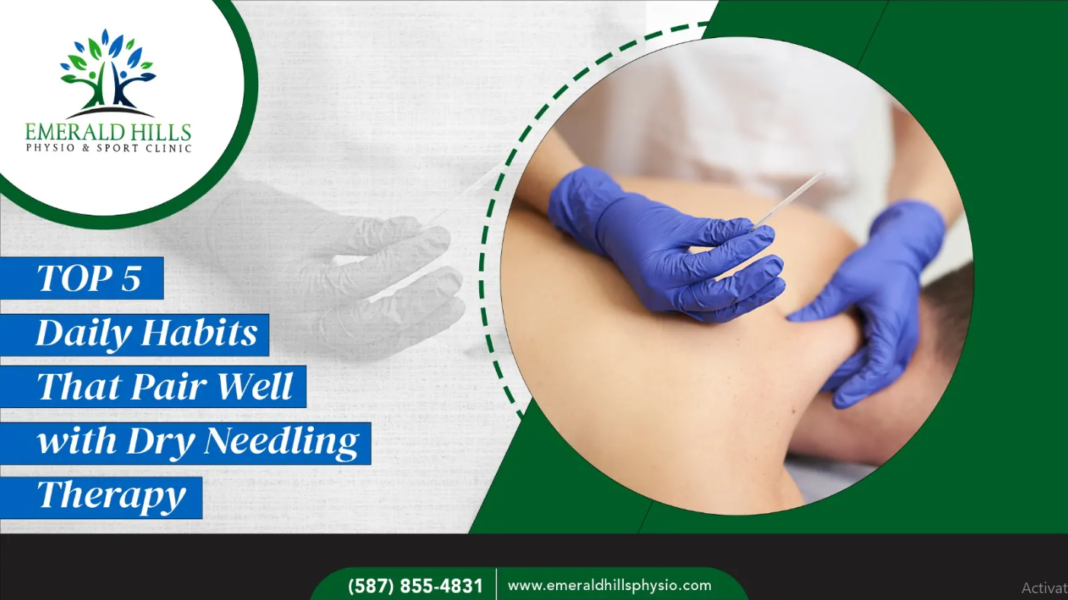If you’re using dry needling to help with muscle tightness, pain, or movement restrictions, the care doesn’t end when you leave the clinic. How you move, rest, and recover each day plays a big role in how effective dry-needling therapy will be for your body. Dry needling has quickly become a go-to therapy for many dealing with muscle pain, tension, and mobility issues. Whether you’re recovering from injury or just trying to stay pain-free, it’s an effective treatment that targets trigger points and tight muscles.
But there’s more to lasting relief than just showing up to your appointments. Dry needling in Sherwood Park helps to adopt a few easy lifestyle habits that support the body’s natural healing process.
Top 5 Daily Habits That Pair Well with Dry Needling Therapy
Dry needling in Sherwood Park works by releasing tight muscle bands and stimulating healing in deeper layers of soft tissue. It can relieve stubborn tension, improve blood flow, and even reset nerve-muscle communication. But like any effective therapy, what you do between appointments influences how much progress you make.
Here are five simple but impactful daily habits that can enhance the results of dry needling physiotherapy:
1. Stay Hydrated All Day Long
Water is one of the most overlooked yet powerful tools in muscle recovery. After dry needling, your muscles begin the healing process—removing waste products, rehydrating cells, and restoring elasticity. Dehydration slows this down.
What to do:
- Sip water regularly instead of chugging it all at once.
- Put a pinch of sea salt or electrolytes to support better absorption.
- Target for half your body weight in ounces of water daily, adjusting for activity and heat.
Pairing hydration with dry needling therapy helps reduce post-treatment soreness and supports tissue repair.
2. Gentle Movement and Stretching
While rest is important, staying still for too long after dry needling can make muscles feel stiff. Light movement encourages circulation, prevents the buildup of new tension, and helps your nervous system integrate the reset.
What to do:
- Take a short walk within a few hours of treatment.
- Do gentle stretching of the targeted areas, focusing on breathing and staying relaxed.
- Avoid heavy lifting or intense workouts for 24–48 hours post-IMS.
Many people receiving dry needling find that walking, mobility work, and bodyweight stretches are enough to feel more balanced and less tense after therapy.
3. Practice Mindful Breathing or Meditation
Pain and muscle tension are often tied to stress, and dry needling physiotherapy doesn’t just work on muscles; it indirectly affects the nervous system, too. Deep breathing can help maintain that relaxed state and prevent muscles from tightening again due to stress overload.
What to do:
- Spend 5 minutes each day doing slow belly breathing.
- Inhale for four counts, hold for four and exhale for 6.
- Try meditation apps or body scan techniques to release mental and physical tension.
Mind-body practices pair well with dry needling therapy because they calm the system and support long-term changes in how your body holds tension.
4. Prioritize Sleep and Recovery
Your body heals while you sleep; that’s when tissue repair, inflammation reduction, and nervous system regulation happen. Skipping sleep or having a disrupted sleep routine can undo the gains made in your sessions.
What to do:
- Aim for 7–9 hours of quality sleep.
- Stick to a consistent bedtime and reduce screen time before bed.
- Use pillows to support proper sleep posture, especially if you’re working through specific pain points.
For those going through dry needling, quality rest is often the missing piece that allows the treatment to truly settle in.
5. Fuel Your Body with Anti-Inflammatory Foods
Nutrition supports recovery just as much as hydration and sleep. After dry needling, your body undergoes small-scale inflammation as part of the healing process. Giving it the right fuel can make a big difference.
What to do:
- Add foods like leafy greens, berries, turmeric, ginger, fatty fish, and nuts.
- Reduce processed sugar and refined carbs that can heighten inflammation.
- Take balanced meals with protein, healthy fats, and fibre.
These small shifts enhance the natural healing process encouraged by dry needling physiotherapy and can help you feel more energized and less sore day to day.
Why Daily Habits Matter for IMS Therapy
Dry needling therapy works by disrupting muscle knots and stimulating deeper tissue repair, but those changes need support to last. These daily habits are less about being perfect and more about giving your body a consistent environment for healing.
When used as part of a broader movement or recovery plan, dry needling becomes more than just pain relief. It becomes a catalyst for better posture, freer movement, and fewer flare-ups. For those attending dry needling, adopting these supportive routines can extend the life of each treatment session and reduce the number of visits needed.
Keep the Momentum Going
Dry needling can jumpstart your body’s healing process—but it’s your daily habits that keep the momentum going. Hydration, light movement, restful sleep, mindful breathing, and clean nutrition all work together to support deeper recovery. If you’re already receiving dry needling in Sherwood Park, pairing your sessions with intentional routines can lead to quicker results and longer-lasting relief.
For continued care and a supportive environment, Emerald Hills Physiotherapy in Sherwood Park offers personalized approaches to dry-needling physiotherapy that fit your needs and lifestyle. Healing happens in the small moments, too; start building those habits today.

